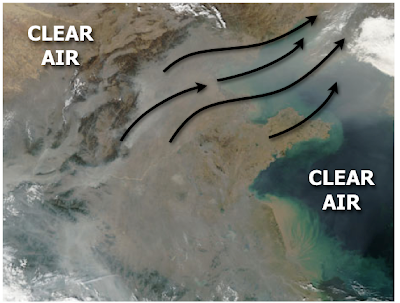Why Climate Scientists Need to Understand Basic Meteorology
Over the summer, I had a rather lengthy discussion with an amateur climate scientist who insisted there was no reason that climate scientists needed to know basic meteorology. I recalled that conversation when I read this paper from Nature Communications. The paper tells us:
- There was accelerated melting of glaciers when distant volcanoes erupted.
- The soot could be carried considerable distances by upper atmospheric winds.
- Because the glaciers were far away, the soot from those volcanoes could fall out of the atmosphere and onto the surface of glaciers.
- That soot darkened the bright while snow and ice cover of the glacier. Darkening a field of snow or ice will cause rapid melting even if temperatures stay the same.
I don't mean to be harsh but any third year meteorology student would have know that darkening a snow cover rapidly accelerates melting. From this blog on December 5, 2009:
So, if temperatures in the Arctic are not warmer than normal during the melt season, what is causing the ice to melt?
The answer is soot pollution, likely from China. This isn't just my theory, there are multiple peer-reviewed paper that have come to the same conclusion. Dark particles on a light snow cover absorb the sun's warmth and turn it to heat, then transfer that heat into the snow, melting it. Let me give you a backyard example.
Under clear skies on December 24, 2007, I spread cold fireplace ash in two rows on a seven inch snow cover.
After four hours, the ash-free area has 5.5 inches of snow (click on images to enlarge):
While the soot-covered areas experienced much faster snow melt, down to 2.5 inches!
It is fine to contend that loss of Arctic ice could have adverse environmental effects. But, the cause of the ice melt isn't "global warming." And, decreasing the amount of carbon dioxide in the atmosphere will do nothing to stop the ice melt if the problem is soot.
The answer is soot pollution, likely from China. This isn't just my theory, there are multiple peer-reviewed paper that have come to the same conclusion. Dark particles on a light snow cover absorb the sun's warmth and turn it to heat, then transfer that heat into the snow, melting it. Let me give you a backyard example.
Under clear skies on December 24, 2007, I spread cold fireplace ash in two rows on a seven inch snow cover.
After four hours, the ash-free area has 5.5 inches of snow (click on images to enlarge):
While the soot-covered areas experienced much faster snow melt, down to 2.5 inches!
It is fine to contend that loss of Arctic ice could have adverse environmental effects. But, the cause of the ice melt isn't "global warming." And, decreasing the amount of carbon dioxide in the atmosphere will do nothing to stop the ice melt if the problem is soot.
As to the soot raining down after being transported long distances, this is from January 11, 2011:
This image is a screen capture from yesterday evening's "NBC Nightly News" photographed from our television screen:
Notice any thing odd about the ice? I'll give you a hint: There is no dirt or soot in the Arctic (just ice and, under the ice, water). Obviously, a foreign substance is on the ice. And, pollution causes ice to melt much faster, even if the temperature is below freezing, if the sun is out. For details, check here.
Where might the dirt/soot have come from? Here's another hint:
This satellite image shows the brownish pollution from China flowing northeast toward the Arctic.
There are multiple peer-reviewed papers attributing the recent summer ice melt in the Arctic to soot rather than 'global warming' as Arctic temperatures have been colder than normal each of the last three summers. Please be clear: I'm concerned about the melting ice. It may be the the melting ice could lead to other climate problems. But, attributing the melt to "global warming" when the problem is really soot accomplishes nothing and may lead to other problems.
The new paper is useful in terms determining when periods of heightened volcanic eruptions occurred and comparing them to the increased meltwater. That said, there is nothing new or novel about volcanic soot causing accelerated melting of glaciers.
Notice any thing odd about the ice? I'll give you a hint: There is no dirt or soot in the Arctic (just ice and, under the ice, water). Obviously, a foreign substance is on the ice. And, pollution causes ice to melt much faster, even if the temperature is below freezing, if the sun is out. For details, check here.
Where might the dirt/soot have come from? Here's another hint:
This satellite image shows the brownish pollution from China flowing northeast toward the Arctic.
There are multiple peer-reviewed papers attributing the recent summer ice melt in the Arctic to soot rather than 'global warming' as Arctic temperatures have been colder than normal each of the last three summers. Please be clear: I'm concerned about the melting ice. It may be the the melting ice could lead to other climate problems. But, attributing the melt to "global warming" when the problem is really soot accomplishes nothing and may lead to other problems.
The new paper is useful in terms determining when periods of heightened volcanic eruptions occurred and comparing them to the increased meltwater. That said, there is nothing new or novel about volcanic soot causing accelerated melting of glaciers.









Comments
Post a Comment